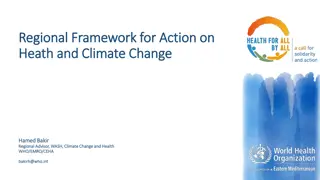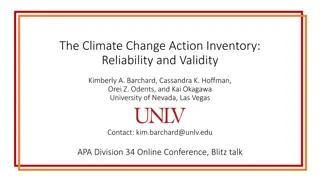National Security Impacts of Climate Change - Insights by Edward P. Richards
Edward P. Richards, JD, MPH, Clarence W. Edwards Professor of Law at LSU Law School, discusses the national security threats posed by climate change, including destabilization of political regimes, extreme weather events, and health impacts. The presentation covers key issues such as the future paradigm in Syria, legal considerations, extreme weather events, and the effects of sea level rise and tropical cyclones.
Download Presentation

Please find below an Image/Link to download the presentation.
The content on the website is provided AS IS for your information and personal use only. It may not be sold, licensed, or shared on other websites without obtaining consent from the author.If you encounter any issues during the download, it is possible that the publisher has removed the file from their server.
You are allowed to download the files provided on this website for personal or commercial use, subject to the condition that they are used lawfully. All files are the property of their respective owners.
The content on the website is provided AS IS for your information and personal use only. It may not be sold, licensed, or shared on other websites without obtaining consent from the author.
E N D
Presentation Transcript
Edward P. Richards, JD, MPH Clarence W. Edwards Professor of Law LSU Law School richards@lsu.edu NATIONAL SECURITY NATIONAL SECURITY IMPACTS OF CLIMATE IMPACTS OF CLIMATE CHANGE CHANGE
National Security Threats Destabilization of political regimes and demographic catastrophes Extreme weather events including catastrophic storms Health impacts including emerging infectious diseases
Destabilization of political Destabilization of political regimes and demographic regimes and demographic catastrophes catastrophes
Syria The Future Paradigm Major drought drove people from the land into the cities. This exacerbates the political unrest from the Arab Spring. Political conflict, not climate (economic) refugees pour into surrounding countries Syria to Bangladesh is subject to climate change destabilization.
Legal Issues Humanitarian aid Military action Diplomatic actions Presidential Powers Commander in Chief Sole organ of foreign policy Will Congress follow?
Extreme weather events Extreme weather events including catastrophic storms including catastrophic storms
Sea Level Rise and Tropical Cyclones At least 2 meters not if, just when Warmer oceans = storms farther north Every river delta will retreat Low land floods Miami, Bangladesh Coastal restoration is nonsense Only coasts with elevation can be defended Massive relocations need decades
Legal Issues Federal Government Stop subsidizing bad decisions National Flood Insurance Program Road Home and other programs that rebuild in the same place Relocate critical infrastructure Mississippi River cargo Federal facilities Incentivize relocation
Legal Issues State and Local Government No more coastal restoration mythology No more building in dangerous areas Incentivize relocation Relocate critical infrastructure Don t subsidize bad decisions with insurance regulation
Health Health impacts, impacts, including emerging infectious diseases emerging infectious diseases including
Climate change connects to many health outcomes Some expected impacts will be beneficial but most will be adverse. Expectations are mainly for changes in frequency or severity of familiar health risks Modulating influences Health effects Human exposures Temperature-related illness and death Extreme weather- related health effects Air pollution-related health effects Water and food-borne diseases Vector-borne and rodent- borne diseases Effects of food and water shortages Effects of population displacement Contamination pathways Transmission dynamics Agroecosystems, hydrology Socioeconomics, demographics Regional weather changes Heat waves Extreme weather Temperature Precipitation CLIMATE CHANGE Based on Patz et al, 2000 15
Some of the largest disease burdens are climate-sensitive Each year: - - Undernutrition kills 3.5 million. - Diarrhoea kills 2.2 million. - Malaria kills 900,000. - Extreme weather events kill 60,000. - WHO estimates that the climate change that has occurred since the 1970s already kills over 140,000 per year. 16
Weather-related disasters kill thousands in rich and poor countries Deaths During Summer Heatwave. Paris Funeral Services (2003) 17
Increases in diseases of poverty may be even more important Diarrhoea is related to temperature and precipitation. In Lima, Peru, diarrhoea increased 8% for every 10C temperature increase. (Checkley et al, Lancet, 2000) 18
Emerging Infectious Diseases HIV/AIDS Habitat and cultural disruption West Nile, Saint Louis Encephalitis Dengue Fever, Zika, Chikungunya Virus Cultural practices water storage Malaria, Yellow Fever, Ebola Pandemic flu and bioterrorism Who knows what?
Legal Issues Local Public Health Public health is uniquely local Public health infrastructure and expertise has been gutted Feds and locals conspire to cover up the problems Local example rates of new AIDS cases Bad leadership at the CDC and Homeland Security























